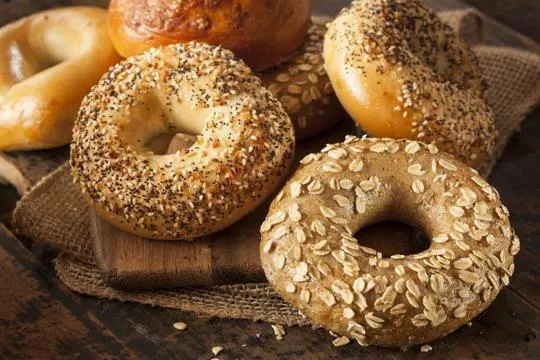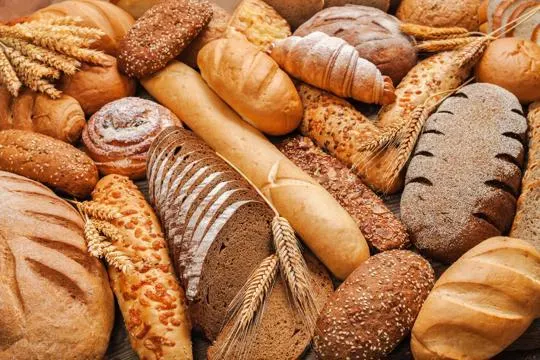Summary of key points
The main difference between bagels and bread lies in their ingredients and preparation method. Bagels are made with flour, water, yeast, and salt but are also boiled before baking, giving them a chewy texture. Bread is typically made with similar ingredients but is not boiled and has a softer texture.
Bagels also have a distinct shape with a hole in the middle while bread can come in various shapes and sizes. In terms of taste, bagels often have a slight tanginess due to the boiling process while bread can have a neutral or slightly sweet flavor.
Both are delicious carbohydrate options that can be enjoyed in different ways – bagels as a breakfast or snack food and bread as a staple for meals.
Bagels and bread aren’t just breakfast options. They’re a lifestyle. Seriously, think about how they start our morning. One’s boiled before baking; the other isn’t. That’s the game-changer.
We’ve all had those mornings. Racing against the clock, you grab a bagel or a slice of bread. It seems trivial, right? Yet, this choice says a lot about us.
Bagels bring that chewy satisfaction, a testament to our need for something substantial. They’re the heavyweights. Bread, on the other hand, is the versatile one, ready for any topping we throw at it.
I remember my first bagel. It was a revelation. The dense texture, the slight crunch. Bread, though, has been with us forever. It’s the comforting friend we all rely on.
Both have their place at our table. Next, we’ll deep-dive into what really sets them apart. Stay tuned.
What is a Bagel?

A bagel is a famous bread product from Poland.
Its unique texture and shape, with a hole in the center, is renowned.
It’s usually made of wheat flour, yeast, water, salt, and sometimes sugar.
Boiling before baking gives it flavor and texture.
Bagels come in many flavors and toppings, like sesame seeds, poppy seeds, or garlic.
Enjoy them plain or with spreads like butter, cream cheese, or jam.
Bagels also make great sandwiches, or pair with deli meats.
Different from other bread, bagels are denser because of the boiling before baking.
This makes them chewy and slightly crusty outside.
The center hole ensures more even cooking and prevents it from getting too dense.
Bagels are a popular breakfast food all over the world, especially in North America.
They’re often toasted with a spread and a hot beverage.
Many cities have bagel shops to satisfy people’s cravings. Sandwiches also love bagels.
Their sturdy texture holds up well to fillings like smoked salmon, cream cheese, lettuce, tomato, and more.
All in all, bagels offer a unique taste and texture compared to other bread.
Their airy yet dense texture, plus the variety of flavors, make them a favorite snack or meal for many.
Sweet or savory, you really can’t go wrong with a bagel.
What is Bread?

Bread is a classic food made from flour and water.
Yeast or sourdough starter is often used to make it rise.
Then, it’s baked until it’s golden brown.
Extra ingredients can be added like sugar, salt, or fat, to give it more taste and texture.
Grains like wheat, rye, oats, and corn can also be used to make bread.
Bread is enjoyed in many ways and has cultural importance.
From French baguettes to Indian naan bread, each culture has their own recipes.
Bread is a versatile and essential ingredient with lots of diversity and creativity.
It’s a fundamental food item that offers endless possibilities for consumption.
Differences Between Bagel and Bread

Bagels and bread have their own unique traits.
Ingredients and Dough
Ingredients and Dough are essential for distinguishing bagels and bread.
Bagels use high-gluten flour, water, yeast, salt, and sugar.
After mixing, kneading, and rising, the dough is shaped into a round with a hole in the middle.
Bread ingredients vary. Common ingredients are flour, water, yeast/sourdough starter, salt, sugar, or oil.
The dough rises longer than bagel dough.
A special element of bagels – they are boiled prior to baking.
This gives them a chewy texture and glossy exterior.
Bread is usually baked without boiling, resulting in different textures.
Texture and Chewiness
Bagels and bread have distinct differences in terms of texture and chewiness.
Bagels are dense and chewy, ideal for toasting or cream cheese.
Whereas, bread is light and soft, perfect for sandwiches or toast.
This difference in texture makes the two different in taste and use.
Flavor Profile
Bagels and bread have different characteristics.
Bagels have a dense texture and a chewy feel. They tend to be more savory and sweet.
On the other hand, bread comes in various flavors and types.
It can be plain white, whole wheat, or sourdough. Each has its own unique flavor.
Bagels are usually toasted with cream cheese or made into sandwiches.
Bread can be buttered toast or used to make gourmet sandwiches.
So, it all depends on your preference.
Whether you prefer bagels or bread, there’s something for everyone.
Preparation and Cooking Methods
Bagels and bread have distinct differences when it comes to preparation and cooking.
Bagels are boiled before baking, giving them a chewy texture and shiny exterior.
Bread, however, usually rises and then is baked in an oven.
This creates a softer, lighter texture. Ingredients also vary.
For bagels, high-gluten flour is generally used which produces a dense texture.
Toppings, such as sesame or poppy seeds, can be added for flavor.
Bread can be made from multiple types of flour, including whole wheat, rye, and gluten-free.
Shape is another big difference between the two.
Bagels are circular with a hole in the center.
Bread can be in various shapes, like loaf or boule.
The hole in a bagel allows for more even cooking and ensures the center is cooked through.
Finally, bagels are boiled in water with sugar or malt syrup before baking.
This gives them a chewy crust and a soft interior. Bread does not undergo this step.
Overall, although both bagels and bread are popular carbs, their preparation and ingredients differ.
Knowing these differences adds to our culinary knowledge.
Nutritional Comparison: Bagel vs Bread
Bagels and bread are similar. Bagels have a dense texture while bread is more versatile.
Nutritional benefits differ.
Bagels are bigger and have more calories, carbs for energy.
Bread has options for dietary needs, like wheat, multigrain or gluten-free.
Bread can be fortified with vitamins and minerals.
Bagels have more protein due to yeast and malt-based doughs.
The choice depends on individual preferences and nutritional goals.
Cultural and Culinary Context
Bagels and bread have very different cultural and culinary roles.
Bagels originated in Eastern Europe and have a unique chewy texture.
They are made by boiling the dough before baking.
Bread, on the other hand, is a worldwide staple.
It comes in various forms like rolls and buns, and can be made from different grains.
It is usually baked until crispy on the outside, and soft inside.
Though both can be used for sandwiches or toast, their tastes differ.
Bagels tend to be richer because of eggs and oil, while bread has more variety in flavors and textures.
Bagels also have cultural importance in Jewish culture, and are often served at holidays or family events.
Bagel shops are popular in Jewish areas, with lots of different toppings.
In conclusion, bagels and bread are significant in many culinary cultures.
They bring comfort and pleasure to people’s lives, with bagels having chewiness, and bread having more options.
Both are valued around the world.
Similarities Between Bagel and Bread

Bread and bagels have something in common.
They both use flour, water, yeast, and salt as ingredients.
Plus, they’re both baked goods.
Even though they look different, their shape is usually round.
Bread is usually sliced, and bagels have a hole in the middle.
Taste and texture-wise, bread is softer, with an airy crumb.
Bagels, on the other hand, are denser due to boiling before baking.
This gives them a chewy inside and crisp outside.
Culturally, bread and bagels are significant.
Bread has been around for ages in many cultures.
Bagels have a Jewish history, but are now popular everywhere.
Bread and bagels are unique, but share qualities too.
Enjoying either one is a great way to appreciate carbs.
Choosing Between Bagel and Bread: Considerations
Trouble deciding between bagels and bread? They both have great qualities.
Bagels are known for being dense and chewy. Bread offers a softer texture.
Think of your preferences and dietary needs.
Bagels are usually a more substantial meal, often enjoyed with toppings like cream cheese, smoked salmon, or avocado.
Bread is perfect for sandwiches and toast, as it can be used with many fillings – from classic ham and cheese to grilled vegetables or pesto chicken.
Remember bagels are higher in calories and carbs.
Consider your taste, texture, and diet when choosing.
Whether you want a breakfast sandwich or toast, both will satisfy your craving in their own unique ways.
Conclusion
Bagels and bread are two very delicious on-the-go snacks.
As we have explored in this blog, the differences between them can range from calorie count to ingredients used in preparation.
Ultimately,it is up to the individual to decide whether bagel or bread is the healthier option; both offer a great snack alternative when in a bind.
Though they may have similarities, ultimately the outcome of each item differs greatly.
What’s clear from our exploration of these options is that for any bagel lover out there, they should bear in mind that purchasing fresh-baked bagels wherever possible is always better than store bought.
With all this information in mind, I’m sure you can now make an informed decision about which one you choose and choose wisely.

Leave a comment